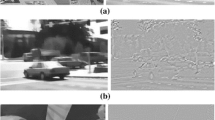Abstract
The motion of brightness patterns in an image sequence (optical flow) is most intuitively considered as a spatiotemporal phenomenon. It has been shown, however, that motion has a characteristic signature in the spatiotemporal-frequency (Fourier) domain. This fact can be exploited for the computation of optical flow. However, for cases which involve a number of regions in a sequence with different motions, as in scenes with one or more objects moving against a stationary or moving background, the global nature of the Fourier transform makes it unsuitable for this task. The signatures of the different motions cannot be resolved in the Fourier domain, nor associated with their respective regions in the image sequence. Local frequency representations provide a means to address this problem. In this paper, we consider the application of a 3-D version of the widely used Gabor transform to the computation of optical flow.
Similar content being viewed by others
References
B. K. P. Horn, and B. G. Schunk, “Determining Optical Flow,” Artificial Intelligence, vol. 17, no. 1–3, 1981, pp. 185–203.
A. B. Watson, and A. J. Ahumada, “A Look at Motion in the Frequency Domain,” SIGGRAPH/SIGART Interdisciplinary Workshop MOTION: Representation and Perception, Toronto, Canada, April 4–6 1983, pp. 1–10.
G. Cortelazzo, and M. Balanza, “Frequency Domain Analysis of Translations with Piecewise Cubic Trajectories,” IEEE Trans. PAMI, vol. 15, no. 4, 1993, pp. 411–416.
H. Gafni, and Y. Y. Zeevi, “A Model for Separation of Spatial and Temporal Information in the Visual System,” Biol. Cybern., vol. 28, 1977, pp. 73–82.
B. Porat, and B. Friedlander, “A Frequency Domain Algorithm for Multiframe Detection and Estimation of Dim Targets,” IEEE Trans. PAMI, vol. 12, no. 4, 1990, pp. 398–401.
A. Kojima, N. Sakurai, and J. Kishigami, “Motion Detection Using 3D–FFT Spectrum,” Proc. of IEEE ICASSP' 93, Minneapolis, Minnesota, April 27–30, pp. 213–216.
H. Gafni, and Y. Y. Zeevi, “A Model for Processing of Movement in the Visual System,” Biol. Cybern., vol. 32, 1979, pp. 165–173.
H. Jacobson, and H. Wechsler, “Derivation of Optical Flow Using a Spatiotemporal–Frequency Approach,” Computer Vision, Graphics, and Image Processing, vol. 38, 1987, pp. 29–65.
D. Gabor, “Theory of Communication,” Proc. of the Inst. of Elec. Eng., vol. 93, no. 26, 1946, pp. 429–457.
T. Ebrahimi, T. R. Reed, and M. Kunt, “Video Coding Using a Pyramidal Gabor Expansion,” Proc. of VCIP' 90, Lausanne, Switzerland, October 2–4, pp. 489–502.
Author information
Authors and Affiliations
Rights and permissions
About this article
Cite this article
Reed, T.R. On the Computation of Optical Flow using the 3-D Gabor Transform. Multidimensional Systems and Signal Processing 9, 447–452 (1998). https://doi.org/10.1023/A:1008431029442
Issue Date:
DOI: https://doi.org/10.1023/A:1008431029442




